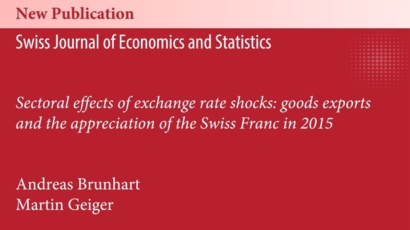Article on the sectoral effects of exchange rate shocks on goods exports published in the «Swiss Journal of Economics and Statistics»
Exchange rates play a key role in the transmission of macroeconomic shocks and have direct implications for relative prices, international competitiveness, external trade imbalances, and the effectiveness of monetary policy. They are also important drivers of business cycle fluctuations. These relationships are particularly relevant in the Swiss Franc currency area of Switzerland/Liechtenstein, as the Franc has undergone a continuous and significant appreciation since 2007, which poses a major challenge for the export industry, which is highly important in both countries.
The article by Andreas Brunhart and Martin Geiger, published in the Swiss Journal of Economics and Statistics, uses granular monthly customs data from a broad sample of OECD countries and the «synthetic control method» to analyze how Swiss goods exports would have developed if the Swiss National Bank had not abandoned its minimum exchange rate target in January 2015. Since this unexpected and sudden appreciation of the Swiss Franc could not have been anticipated by economic actors, it is well suited as a «quasi-natural» experiment to examine the impact of exchange rate shocks not only at the aggregate level but also at the sectoral level by comparing the estimated counterfactual scenario with the actually observed data. The study also evaluates the variation in results across sectors and units of measurement (goods exports in Swiss francs, euros, or real terms) and explains it with industry-specific characteristics of the various industrial sectors.
The estimations show an immediate positive effect of the exchange rate shock on total nominal exports measured in Euros (due to currency conversion) and an overall negative effect on nominal exports in Francs, but no significant effect on real export quantities. This suggests that both the goods demand and supply sides are involved in the transmission of the shock and indicates that the Swiss export industry is highly resilient overall. At the sectoral level, however, marked differences in the response to the shock can be identified. The differences in sectoral adjustment can be linked to industry-specific characteristics. Larger profit margins, for example, allow price reductions in local currency to prevent an increase in product prices in foreign currency as a result of the appreciation. Thus, greater scope for supply adjustments in the chemical and pharmaceutical sector means that an exchange rate shock is less detrimental in this sector. In contrast, the mechanical engineering industry typically does not have such scope.
To the extent that monetary policy influences the exchange rate, its real impact therefore depends on the sectoral composition of the export industry. Economic policy should take these sectoral heterogeneities into account when calibrating monetary and fiscal policy support measures, as well as pronounced regional differences in the impact as a result of sectoral composition – as in the case of the Swiss chemical and pharmaceutical sector, which is dominated by large companies concentrated mainly in the Basel area.
The analysis of the exchange rate impact on exports from Swiss industrial sectors also allows conclusions to be drawn about the impact on Liechtenstein’s export economy. For instance, because Liechtenstein does not have a large pharmaceutical sector as it the case in Switzerland, but is much more focused on metal construction and mechanical engineering.









